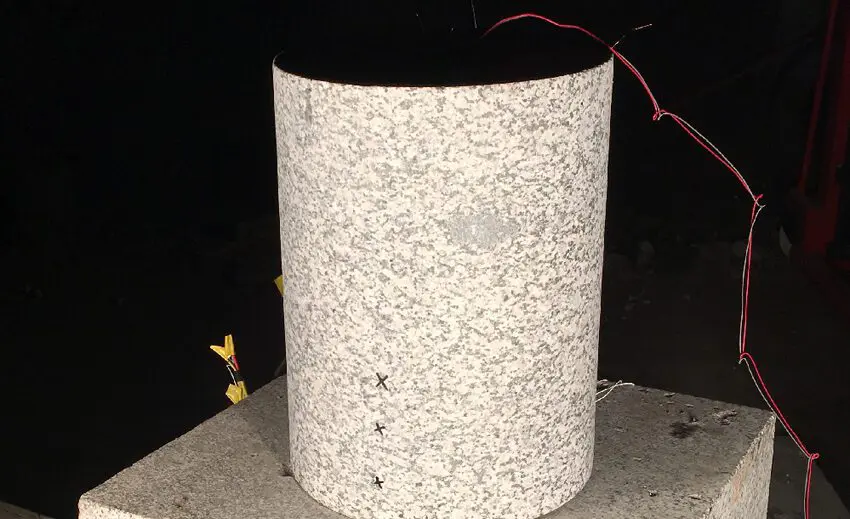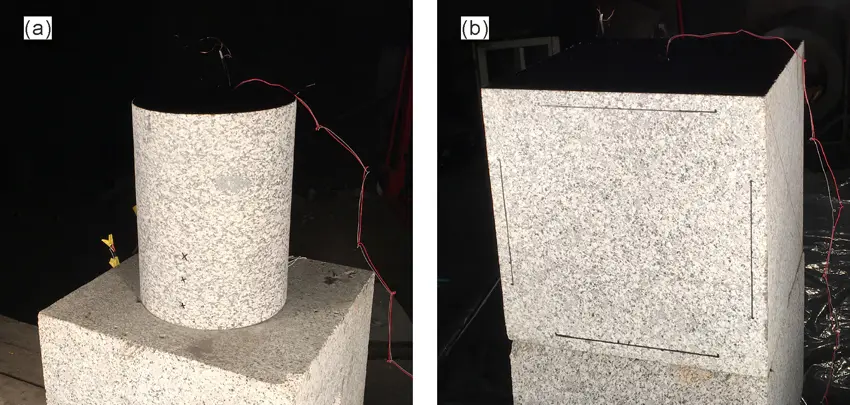Understanding better fundamental mechanisms of rock fracture by blasting

Top image: Cylindrical speciments prior to blast tests. Photo: Liyuan Chi/UNIS.
UNIS PhD candidate Liyuan Chi has investigated the shock compression of rock in the vicinity of an exploding charge and rock fracturing on a free surface parallel to the blast hole. Chi will defend his PhD thesis at NTNU on Wednesday 21 November at 13:15.
14 November 2018
Press release from the University Centre in Svalbard (UNIS) and Norwegian University of Science and Technology (NTNU)
Rock blasting is one of the most important operations in hard rock engineering works, especially in mining and tunneling. Current rock blasting practices are primarily based on empirical designs, and mechanisms of rock fracture by blasting are not clear. An improved and scientifically based blast design depends on a better understanding of the fundamentals of rock blasting, which include detonation physics, shock-wave charact eristics, rock fracturing and fragment movements. This PhD thesis mainly investigates the shock compression of rock in the vicinity of an exploding charge and rock fracturing on a free surface parallel to the blast hole.
Small-scale blast tests were carried out with granite cylinders and cubes. The tests were divided into three parts, which correspond to three separate but closely connected topics of the thesis. The logical order for the three parts is based on the distance to explosive charges; starting from the vicinity of charges to the free surface of the specimens.
Part 1 focused on pressure and attenuation of shock waves in granite. Ten test granite cylinders were subjected to explosion from pressed trinitrotoluene (TNT) charges placed centrically in the specimens. Three cylinders had dimensions Ø150 mm × 200 mm; seven had dimensions Ø240 mm × 300 mm. All the specimens had concentric holes drilled from both ends: one 20-mm hole to place the explosive charge and one 50-mm hole to insert a granite plug equipped with Manganin gauges, which measured the pressure of shock waves. One or two gauges were used in each inserted cylinder at distances 7, 15, 22 or 35 mm from the explosive charge in the axis direction of cylinders. As the detonation-type explosion occurred, the measurement results indicated that the peak pressure varied from 4.4 GPa to 15.9 GPa depending on the distance from the explosive, with pressure rise time of ~0.5 μs. An exponential relation between the peak shock pressure and the distance was found on the basis of the measurement results with an attenuation factor of 0.04. For specimens with two gauges, shock-wave velocities in granite various distances from the explosive ranged from 4.58 mm μs-1 to 5.34 mm μs-1. As the deflagration-type explosion occurred, the measured peak pressure was 1.35 GPa 11 mm from the charge, with a 16 μs pressure rise time.
Part 2 included nine blast tests on granite cylinders with a diameter of either 228 mm or 240 mm and a length of 300 mm, with fully coupled or decoupled explosive charges.
The granite cylinders were confined by steel tubes with an inside diameter of 268 mm. The gap between was left either empty, filled with gravel or filled with cement grout. This was implemented to simulate free, semi-confined or fully confined boundary conditions, respectively. The fractures around the blast hole were examined on the cross-sections of the cylinders. For the specimens with fully confined boundary, the diameter of the expanded borehole from a fully coupled charge was up to 2.37 times the initial borehole diameter, and the value at the decoupling ratio of 1.75 was approximately 1.1 times the initial diameter. The size of the crushed zone for the same specimens (decoupling ratio is 1.75) was 1.32~1.56 times the initial diameter. As the decoupling ratio was 3.5, the borehole expansion and the crushed zone were not observed. Combining with other studies, the results indicated that the borehole expansion and the crushed zone depended on the decoupling ratio, the properties of the explosive (such as the density and the VOD), and the given confinement. For small-weight charges, the cylinders confined by gravel fill developed more radial cracks than those observed in the cylinders confined by cement fill. The length and opening of the cracks were also larger in the gravel fill cylinders. For large-weight charges, a cylinder with empty gap was fragmented into very small pieces, while a cylinder with cement fill was broken into large fragments. Hoop strains measured on the steel tubes were smaller for a specimen with gravel fill than for a similar one with cement fill. For a cylinder with empty gap, fragment collisions with the steel tube caused significant hoop strains in the confining steel tube.
Part 3 dealt with six blast tests with six granite cubes (400 × 400 × 400 mm3) using a combination of data collected from strain gauges and generated by digital image correlation (DIC) analysis of pictures captured using a high-speed camera. The maximum concentration of strain obtained from the DIC analysis corresponded well to the dominant cracks and fracture patterns observed on the specimens. By combining the results from the strain gauges and the results from the DIC analysis, the dominant cracks observed on the front surface were found to initiate from or around the surface rather than from the cracks radiating from the borehole. For the fracture pattern on the monitored specimen surface, the increase in charge length primarily influenced the number of dominant vertical cracks, rather than the number of dominant horizontal cracks. From the image analysis, charge weights markedly affected the initiation time for macroscopic cracks and the gas ejection time. By tracing the in-plane motion of corner fragments, it was found that the translational velocities were directed mainly transversely to the charge axis and that the velocity magnitudes were influenced by the charge weights.
The experimental findings of this investigation may contribute to a better understanding of the fundamental mechanisms of the rock fracture by blasting. It may also be useful to verify numerical models that simulate the blasting process.

PhD defense
Liyuan Chi will defend his thesis entitled “Shock Compression and Fractures in Laboratory Rock Blasting” on 21 November at 13:15 in Auditorium H1, Hovedbygget Gløshaugen, NTNU.
He will hold a trial lecture, entitled “Blasting technology and explosives industry in China – a comparison to Europe”, at the same place on 21 November at 10:15.
The committee consists of professor Jose A. Sanchidrian, Universidad Politecnica de Madrid, Spain; regional leader Vegard Olsen, Franzefoss Pukk AS, Norway and associate professor Pål Drevland Jakobsen, NTNU.
The PhD work has been conducted at UNIS. Main supervisor has been professor Zongxian Zhang, Oulu University. Co-supervisors have been professor Charlie Chunlin Li, NTNU and professor Arne Aalberg, UNIS.

About the candidate
Liyuan Chi was born in 1989 in Urumqi, China. In 2014 he completed his master’s degree at the Beijing Institute of Technology.
In September 2014 he started his PhD studies at UNIS and NTNU.
E-mail: Liyuan.Chi@unis.no / Liyuan.Chi@ntnu.no